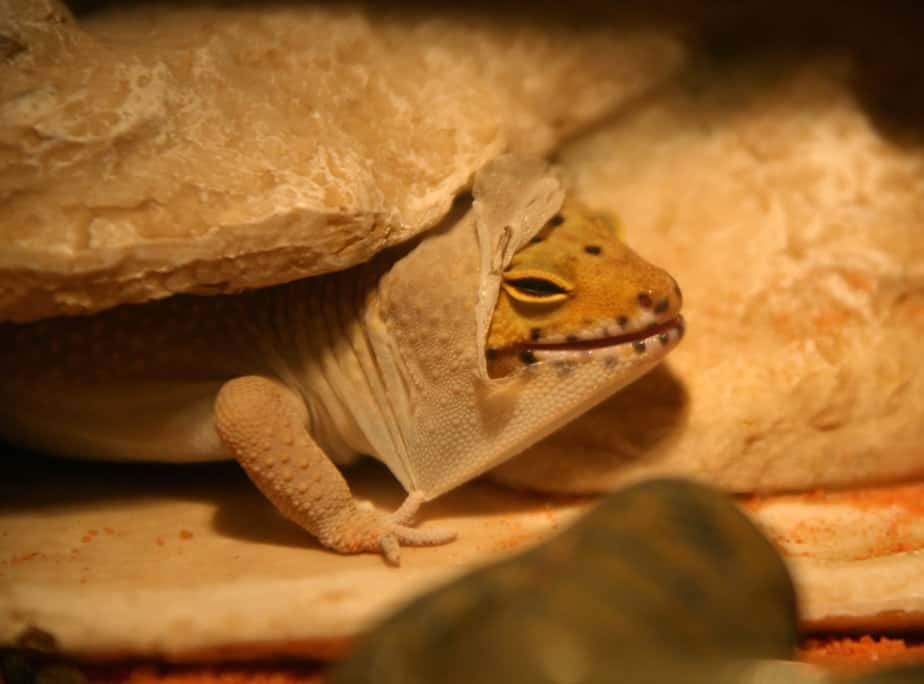As a leopard gecko owner, you might be curious about your pet’s shedding habits. Knowing the frequency and signs of shedding can help you better understand and care for your gecko. So, how often do leopard geckos shed?

Adult leopard geckos shed once every four to eight weeks. Young leopard geckos shed more often than adults, typically once every week or two. Keep an eye out for a duller, more opaque appearance in your gecko’s skin, which indicates an upcoming shed.
Make sure the humidity level in their enclosure is appropriate, and provide a moist hide to make shedding easier.
With proper care, you can ensure that your leopard gecko experiences a healthy and stress-free shed.
Leopard Gecko Shedding Basics
Shedding is a natural part of a leopard gecko’s life cycle and occurs when they outgrow their current layer of skin.
Several factors can influence the frequency of your leopard geckos shedding cycle, such as the gecko’s growth rate, physical condition, and reproductive status.
It’s essential to closely monitor your leopard gecko while shedding to identify potential problems. An unhealthy or stressed gecko might encounter difficulties.
To support your gecko, here are a few simple tips:
- Maintain a consistent temperature and humidity level in the enclosure. This will help prevent a dry or stuck shed.
- A moist hide box filled with damp moss or a wet paper towel can make things more comfortable.
- You can also provide a shallow water dish for your gecko to soak in, which can assist.
Keep an eye on your gecko’s behavior during shedding. If you notice any irregularities or issues, such as stuck shed, you might need to intervene by gently helping to remove the stuck shed or consulting a reptile veterinarian if the problem persists.
Factors Affecting Shedding Frequency
In this section, we’ll discuss various factors that can affect shedding frequency in leopard geckos. These factors include age and growth rate, health and diet, and environmental conditions.
Age and Growth Rate
Younger leopard geckos tend to shed more frequently than their older counterparts. This is because they experience rapid growth, which requires them to shed their skin more often.
Young geckos can shed weekly or bi-weekly, while mature geckos shed about once a month on average. However, individual variations exist, and frequency may vary based on the factors mentioned below.
Health and Diet
A gecko fighting off illness may not have enough energy to shed as frequently. Even a mild infection can delay the shedding process.
Feeding your gecko a balanced and nutritious diet can help maintain its health and prevent shedding issues. A healthy diet can also support their growth rate, which will influence their shedding frequency.
Environmental Conditions
Proper environmental conditions are essential for your leopard gecko’s well-being while shedding.
- Temperature: Maintain a thermal gradient in your gecko’s enclosure, with a basking spot around 88-92°F (31-33°C) and a cooler area around 75°F (24°C).
- Humidity: Adequate humidity is crucial for successful shedding. Leopard geckos come from arid environments. A slightly higher humidity level (around 40-60%) can be maintained to facilitate shedding and prevent stuck shed.
Observing the Shedding Process
Understanding and observing your leopard geckos shedding process is essential for its proper care and health.
Signs of Impending Shed
There are several indicators that shedding is about to begin. Some of these signs include:
- Dull-looking skin
- Lethargy and hiding more often
- A possible loss of appetite
Monitoring Health
Keep an eye on your leopard gecko’s overall health. Regularly check on your gecko to ensure it’s not experiencing any difficulties with shedding.
After shedding, your gecko might eat its old skin. This is normal and provides additional nutrients for them. Check their environment for any leftover skin, as this could indicate an incomplete shed.
Common Issues and Solutions
Some common issues that could occur include:
- Stuck shed: If your leopard gecko does not shed its skin completely, provide a moist hide or gently remove the leftover skin with a damp cotton swab. Do not force the skin off, as this may cause injuries.
- Loss of appetite: It’s not uncommon for a leopard gecko to lose its appetite before shedding. If this continues after the process is complete, consult a veterinarian.
- Stress: A stressed leopard gecko might have difficulty shedding. Make sure their environment is clean and safe, and provide ample hiding spots for them to feel secure.
- Leopard Gecko not shedding: If your Leo has gone more than 6 weeks between sheds you probably need to get it to a vet.
